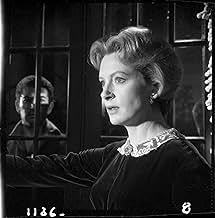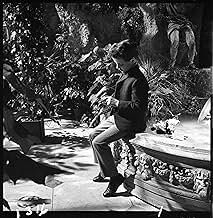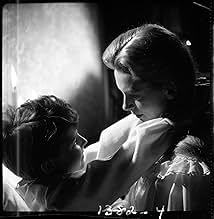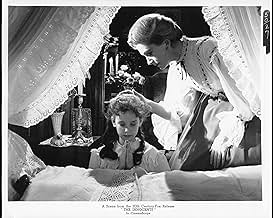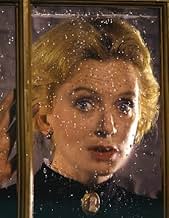Uma jovem governanta de duas crianças se convence de que a casa e o terreno são mal-assombrados.Uma jovem governanta de duas crianças se convence de que a casa e o terreno são mal-assombrados.Uma jovem governanta de duas crianças se convence de que a casa e o terreno são mal-assombrados.
- Direção
- Roteiristas
- Artistas
- Indicado para 2 prêmios BAFTA
- 4 vitórias e 5 indicações no total
Avaliações em destaque
Watching the movie, I could see some similarities to "The Shining" and "The Others". It just goes to show that real horror comes not from blood and guts, but from what the viewer doesn't know. There were a few scenes in this movie that made my blood freeze a little bit. Without a doubt it was a solid achievement for Clayton, Kerr, and also Truman Capote (who co-wrote the screenplay). Definitely one that I recommend.
The story revolves around an uncle who doesn't have time for the children he has inherited, and therefore hires Miss Giddens (Deborah Kerr) to look after them. When Miss Giddens arrives at the mansion, she first meets Flora, the young girl and is 'enchanted' by the child. A few days later the boy, Miles, arrives at the house after being expelled from school. The fourth lead is made up by the housekeeper, Mrs Grose; played by Meg Jenkins. From the housekeeper, Miss Giddens eventually learns of what happened to the previous occupants of the house, and that's where the fun starts...
Martin Stephens (Miles) and Pamela Franklin (Flora) do surprisingly good jobs as the two adorable young children that are the centre of the story. Their characters are portrayed as nice young children, but at the same time there is something sinister about them, and that is where the tale draws a lot of it's suspense and mystery from. Deborah Kerr also shines as the watcher of the children. We know from the outset that her character loves children, which makes her plight believable to the audience when she does all she can to save the children from the evil she believes is haunting them. We never really know what is happening in the movie; the children's viewpoints contradict that of Miss Giddens, and as there is evidence to support what both sides say, along with evidence to support that of the contrary, the mystery is able to build itself through this and that, therefore, along with the empathy we are able to feel for Mrs Giddens due to the nature of her character; the film is able to remain interesting and suspenseful for it's running time.
The thing that this film does best is in capturing a dark and foreboding atmosphere. Through the way the story is portrayed and the beautiful cinematography, Jack Clayton is able to create scenes and sequences that are genuinely frightening and suspenseful; less is more rarely works to a great effect, but here it does. The 'ghosts' have very little screen time, but the time they do have is powerful and memorable enough to make it seem like much more. The film's creepy and menacing atmosphere never delves into violence or gore and relies solely on the story itself and the Gothic, atmospheric setting; and that is much to the film's credit.
If you liked the slightly later 60's paranoid horror films, such as Carnival of Souls or The Haunting, then this film is definitely one to check out.
Based on Henry James' novella, "The Turn Of The Screw," the story is deceptively simple. An inexperienced governess is hired to care for two orphaned children in an isolated British manor and slowly comes to believe the ghosts of the previous governess and her brutish lover are trying to possess the children's souls. Being a decent woman "who loves children," she fights back the only way she can -- by confronting the evil head on. But the question is, does the evil truly exist...or is it all in her own mind?
As told by James, the novella is a startling ghost story, without question. He adds his usual psychological insights to the characters, but never do you doubt the ghosts exist. The defining moment comes when Miss Giddens sees Quint's face in a dark window then later finds a locket bearing his portrait and comes to her realization, "Oh, he's a ghost!" But in the movie, Truman Capote and William Archibald reverse this sequence -- she finds the locket first and THEN sees the man's face in the window -- and all simple explanations go out the door.
Is Miss Giddens imagining things? Has she become overwhelmed by the responsibility of raising two precocious children without any sort of support from their selfish uncle? Is she merely sexually repressed and immature enough to transfer her crush on the uncle to a boy not even into puberty yet? And what of Flora, Miles' sister? If this is merely sexual repression on Miss Giddens' part, then why does she drag a little girl into the morass? Throughout the film, Miss Giddens offers evidence of her concerns -- a letter received from Miles' schoolmaster that she cannot fully share with Mrs. Grose because the woman cannot read; her awareness that the two innocents in her charge have a far more advanced knowledge of life than children that age normally would; stories told by Mrs. Grose about Miss Jessel and Quint and how they treated the children. So could it be the spirits of two miserable adults have come back to reclaim life in the persons of Miles and Flora? It could go either way.
There is not one wrong moment in this movie. Not one. The first time I saw it was in New York City on a double bill with "The Haunting" (1963), a "things that go bump in the night" kind of movie. The audience and I howled through that one, it was so much silly fun. And we chuckled through the first ten minutes of "The Innocents" (especially when Mrs. Grose tells Miss Giddens, "I'm SO glad you're here," with a little quiver in her voice), but by the end of that film (and I use the word "film" deliberately), the entire theater was dead silent. Any film that can shut up a room full of rowdy New Yorkers has got to be damned good.
So...is "The Innocents" a ghost story or psychological study? Who can say? And to be honest, who cares? It is, at the very least, a damned good movie...and at the very best, a horror story that makes "The Shining," "Rosemary's Baby," "The Others" and even "Psycho" (a movie I love) look like the works of children. That this film is not available on DVD is a travesty.
The first screen adaptation of Henry James's "The Turn of the Screw, " a psychological ghost story that leaves unanswered the question of whether the ghosts are real or imagined. This sort of story is pretty common in movies of the last 20 years but was much less so in 1898 or even 1961. Don't let the ambiguity put you off that there are no scares here. This is a movie full of spooky moments, shadowy figures, startling reflections, eerie voices. It's beautifully photographed by Freddie Francis. The music and sound effects add to the feeling of unease. Deborah Kerr gives a nail-biting performance as the neurotic, repressed Miss Giddens. The child actors, Pamela Franklin and Martin Stephens, are sufficiently precocious and weird to keep you off balance as to the truth behind their possession. Stephens was the leader of the kids in Village of the Damned. Franklin would go on to appear in such '70s greats as And Soon the Darkness and The Legend of Hell House. Megs Jenkins is good as the kindly housekeeper. Peter Wyngarde is creepy as the menacing Quint.
The pace is slow, which will turn off impatient viewers, and the scares are subtle and not as visceral as most modern horror fans seem to enjoy. But if you like thoughtful horror films then this is one you'll want to see. Fans of the suggestive classics Val Lewton produced in the '40s should also check this out.
Você sabia?
- CuriosidadesTo create such sharp visuals, director of photography Freddie Francis used lots of huge bright lamps. Deborah Kerr sometimes had to resort to wearing sunglasses between takes. He also had candles custom made with four or five wicks entwined to produce more light.
- Erros de gravaçãoAn obvious center back zipper in several of Miss Kerr's costumes, as well as in Mrs. Gross & Flora's costumes. The Innocents is set during the Victorian period, 1837-1901. Commercial zippers were not used in clothing until 1925.
- Citações
Miles: What shall I sing to my lord from my window? What shall I sing for my lord will not stay? What shall I sing for my lord will not listen? Where shall I go when my lord is away? Whom shall I love when the moon is arisen? Gone is my lord and the grave is his prison. What shall I say when my lord comes a calling? What shall I say when he knocks on my door? What shall I say when his feet enter softly? Leaving the marks of his grave on my floor. Enter my lord. Come from your prison. Come from your grave, for the moon is a risen. Welcome, my lord.
- Cenas durante ou pós-créditosThe film begins with a totally black screen and the sound of Flora singing for several seconds; then the 20th Century Fox logo fades in and out. The singing continues for a few seconds before the opening credits begin. As the credits display, we see an anguished Miss Giddens praying on the left side of the screen. Her actions are not explained until the film's climax.
- ConexõesFeatured in Aweful Movies with Deadly Earnest: The Innocents (1974)
Principais escolhas
Detalhes
- Data de lançamento
- Países de origem
- Idioma
- Também conhecido como
- Posesión satánica
- Locações de filme
- Empresa de produção
- Consulte mais créditos da empresa na IMDbPro
Bilheteria
- Orçamento
- £ 430.000 (estimativa)
- Faturamento bruto mundial
- US$ 30.221
- Tempo de duração1 hora 40 minutos
- Cor
- Proporção
- 2.35 : 1
Contribua para esta página




